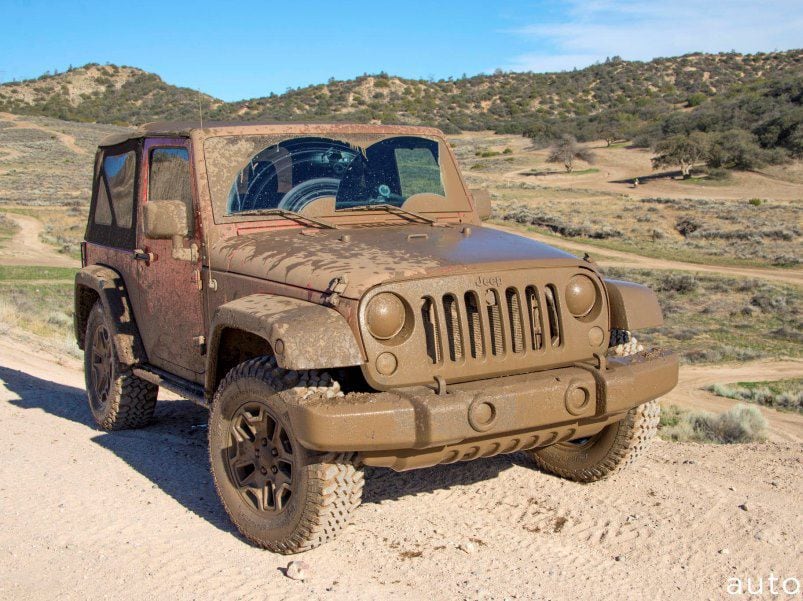Recent Articles
Popular Makes
Body Types
2015 Jeep Wrangler Willys Wheeler Review
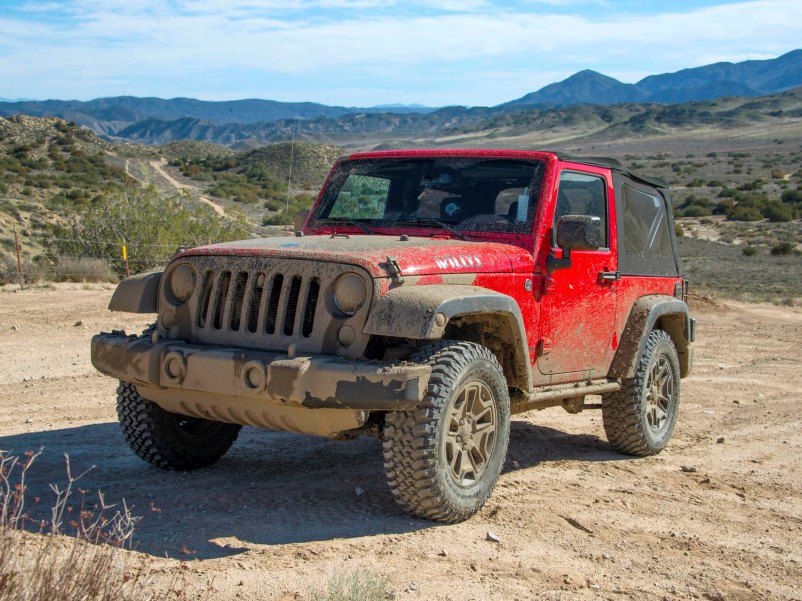
2015JeepWranglerWillysWheelerReview4
Bounding wildly over imposing dirt moguls designed to abuse motocross riders, the two-door Jeep feels completely unfazed. The pitch of its V6 engine remains constant, the coil suspension refuses to bottom out, and there isn’t a squeak or rattle from the chassis.
However, it’s a completely different story for the two of us inside the cabin. My son’s head repeatedly brushes the overhead roll bar – thankfully well padded – and my left knee crashes into the door panel with each sudden dip.
Yet I can’t think of anything else I’d rather be doing than hammering this mud-covered Jeep through a challenging course, son by my side. It’s a proverbial you-can’t-script-better-scenes Kodak Moment.
The 2015 Jeep Wrangler was designed specifically for tortures of this type, and the Willys Wheeler trim level I am driving is further equipped with heavy-duty upgrades to make the task of taking on tough terrain that much easier.
Styling and Design
In 1987, Jeep introduced a redesigned Wrangler (YJ Series) with “modernized” rectangular headlights. Brand loyalists, accustomed to and expecting the traditional round headlights that dated back to the Second World War, went berserk – so Jeep responded with a redesigned model in 1997 (TJ Series) that returned the front headlights to the traditional round shape.
That anecdote sums up the styling of today’s (JK Series) Jeep Wrangler. Don’t expect the sleek aerodynamics, near-flush windows, LED illumination, integrated radio antennae or racy lines found on other late-model cars and trucks on our roads. While the industry moves ahead, the Jeep stays put.
Thanks to its loyal followers, the timeless Jeep Wrangler is stuck in the Dark Ages of automotive design: Its extremely traditional boxiness pays almost unnecessary homage to its war-era predecessors in both design and function. Even today all it takes is a bit of wrenching and the doors come off, the front windshield folds down, and the premium black Sunrider soft top, with tinted plastic windows, may be folded or removed.
Don’t expect things to change, either.
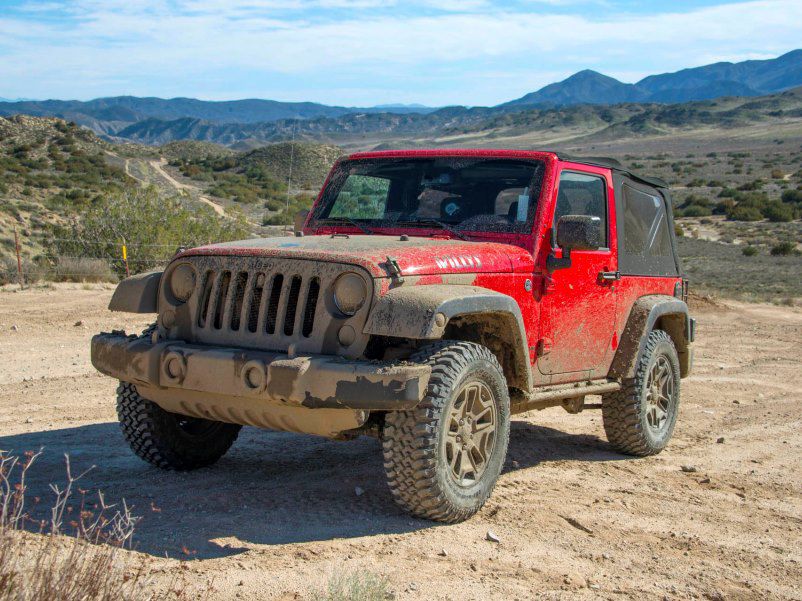
Inside the Cabin
Firmly pressing the button on the oversized plastic handle springs open the door – careful, as it moves freely around its steel hinges with nothing more than a thick nylon strap to keep it from swinging around and nearly hitting the front hood.
The front seats, upholstered in a durable fabric, are supportive and comfortable, but they lack lumbar support, which is often a deal-breaker for me. On a positive note, the driving position is tall and commanding, with decent outward visibility despite the thick A-pillar, padded bars and plastic windows that distort most everything beyond the Jeep’s perimeter. The rear seats are cramped, difficult to climb into and a bit claustrophobic (Jeep offers an Unlimited model, with four doors, for those who frequently carry more than one passenger).
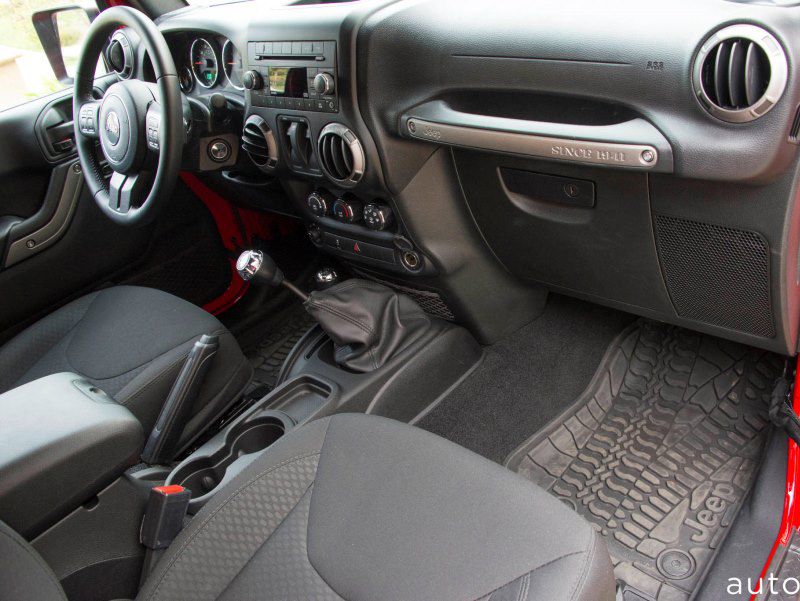
More Civilized
The Jeep’s cabin, with its lack of amenities, appears sparse and uninviting at first glance. A closer examination reveals that today’s Wrangler is much more civilized than its type of even a decade ago, and the Willys Edition arrives with such standard fare as the Connectivity Group, SiriusXM radio, Bluetooth phone connectivity and full power accessories, including keyless entry. However, the ergonomics are questionable at best (for instance, window controls on a vertical console surface and dim interior illumination). Time does improve familiarization with the controls, but it doesn’t alter the physical oddities. Despite being frustrated with the layout, I am pleased to see that Jeep includes a range of engine monitoring gauges on the instrument panel.
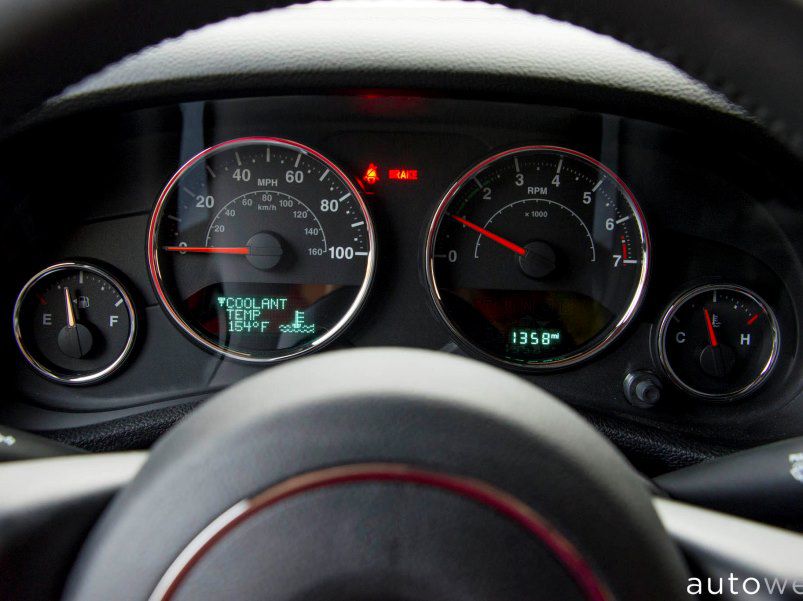
Technology and Innovation
Tech geeks seeking the latest automotive innovation best look elsewhere; the Jeep Wrangler owns the “Old School” crown in today’s rapidly advancing automotive marketplace, which is chock full of vehicles boasting near-autonomous radar-based cruise control, LED headlights and magnetorheological suspension damping. The Jeep’s strength lays in its time-proven ruggedness and ease of being serviced – it is a master in both of those timelessly critical categories.
The most innovative part of the Wrangler, if forced to point a finger, is its increased track (3.4 inches wider than its predecessor), which improves handling and stability. Combined with its modern (government-mandated) safety equipment, including ABS brakes and stability control, the Jeep is more surefooted on-road without sacrificing its off-road talent. Unfortunately, its crash test scores don’t impress: The 2015 Jeep Wrangler Unlimited earned marginal crash test ratings from the IIHS (it has not been tested by NHTSA).
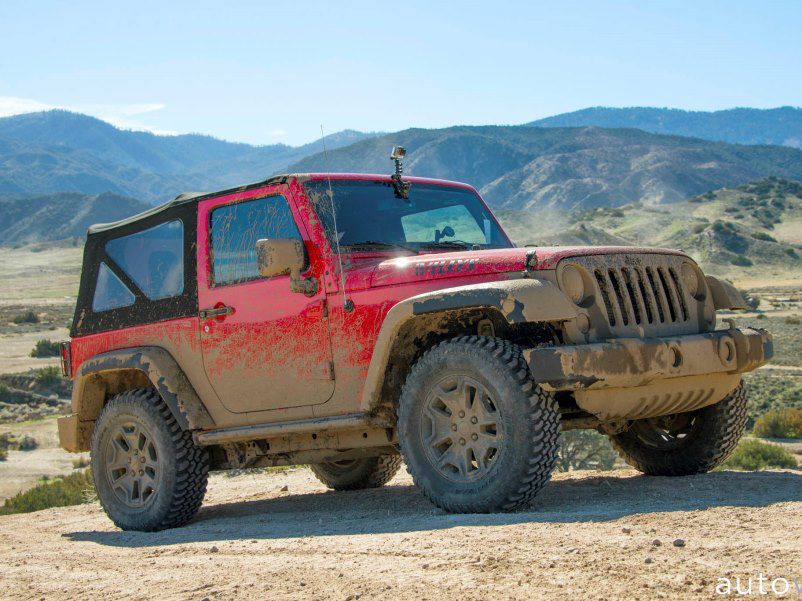
Under the Hood
Like all other Wrangler models sold in the States, the Willys Wheeler is fitted with the automaker’s familiar 3.6-liter Pentastar V6, rated at 285 horsepower and 260 pound-feet of torque and mated to either a traditional six-speed manual or a five-speed automatic transmission.
Jeep based the Wrangler Willys Wheeler Edition on its Wrangler Sport model, but it has enhanced the truck with a slew of mechanical upgrades, including a Dana 44 rear axle with Trac-Lok limited-slip differential and 3.73 gears. The part-time four-wheel-drive system is Jeep’s Command-Trac, which utilizes a two-speed transfer case with a 2.72:1 crawl ratio. Lastly, and very much part of the equation, are standard 17-inch wheels wrapped in aggressive BF Goodrich KM Mud Terrain tires (LT255/75R17) that have tread blocks large enough to swallow a FIAT 500.
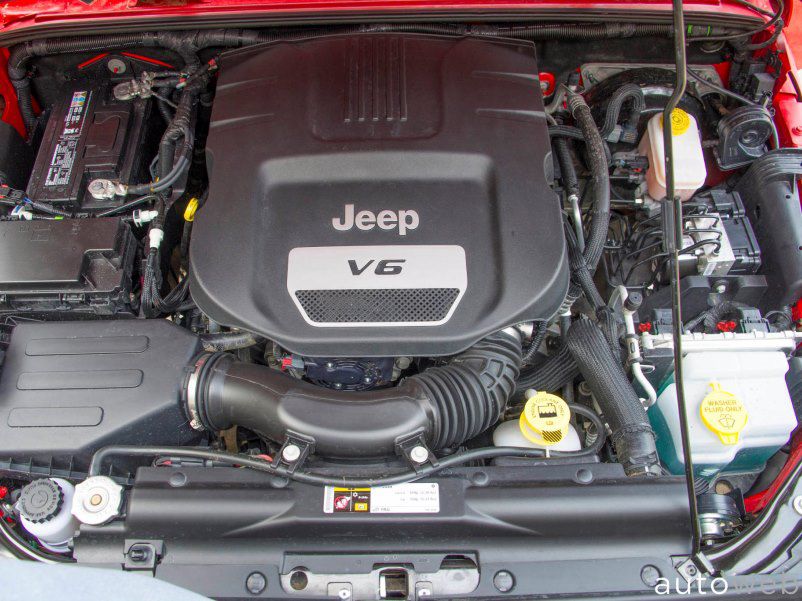
Under the Hood (Con't)
Challenged with a curb weight of nearly 4,100 pounds, the V6 feels overwhelmed on dry pavement. Acceleration is average unless the vehicle is flogged, in which case it will hit 60 mph in just under seven seconds. A sloppy manual gearbox, with long throws, doesn't help the situation around town. On the highway, the Jeep's embarrassing drag coefficient (a large red brick may be more aerodynamic) translates to lackluster throttle response and ho-hum fuel economy ratings: 17 mpg city and 21 mpg highway (the Wrangler does, however, drink less expensive 87 octane, and it comes with a generous 18.6-gallon fuel tank).
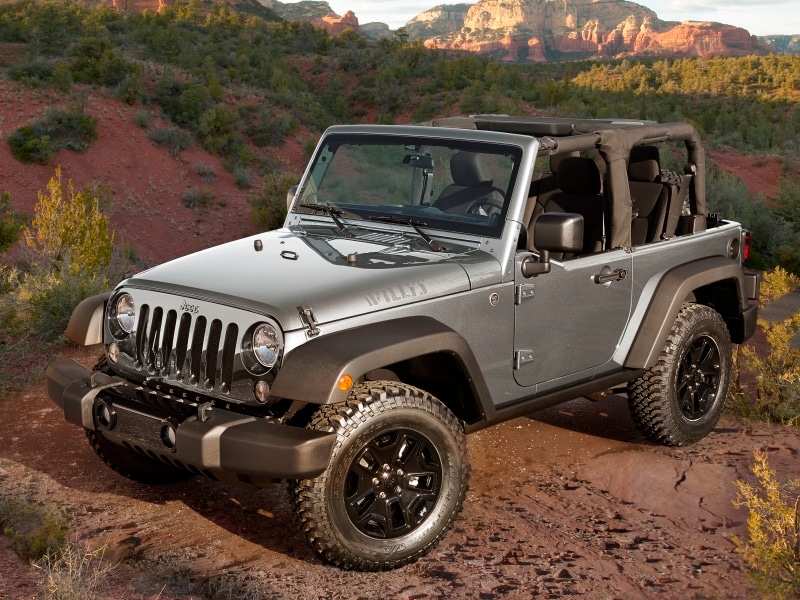
On (and Off) the Road
The Jeep Wrangler, riding on BF Goodrich Mud-Terrain tires, is absolutely miserable on concrete and asphalt – quite possibly one of the least comfortable cars I have ever driven on roads in terms of cabin noise, ride harshness, steering responsiveness, and brake feel. Most of those undesirable qualities can be blamed on the oversized tire tread blocks, but the vehicle’s basic antiquated suspension architecture – heavy solid axles combined with a short wheelbase – is also part of the equation.
Frustrated, but knowing there was a better place for both of us, I journeyed out of the paved Los Angeles Basin to the Hungry Valley OHV, a massive, completely legal off-road “doggie park” for Jeeps and other off-road machines.
Removed from the congested urban environment and allowed to run unencumbered in its preferred wild environment, the truck is nothing short of spectacular. The Jeep’s ground clearance and short wheelbase, pooled with its impressive approach and departure angles, means nothing short of a cinder block wall will hinder its progress. The BF Goodrich Mud-Terrain tires make simple work of the loose dirt, deep sand, smooth rocks and sticky mud, and the vehicle’s 4×4 system (with a lever-activated low range) give it the climbing tenacity of a mountain goat.
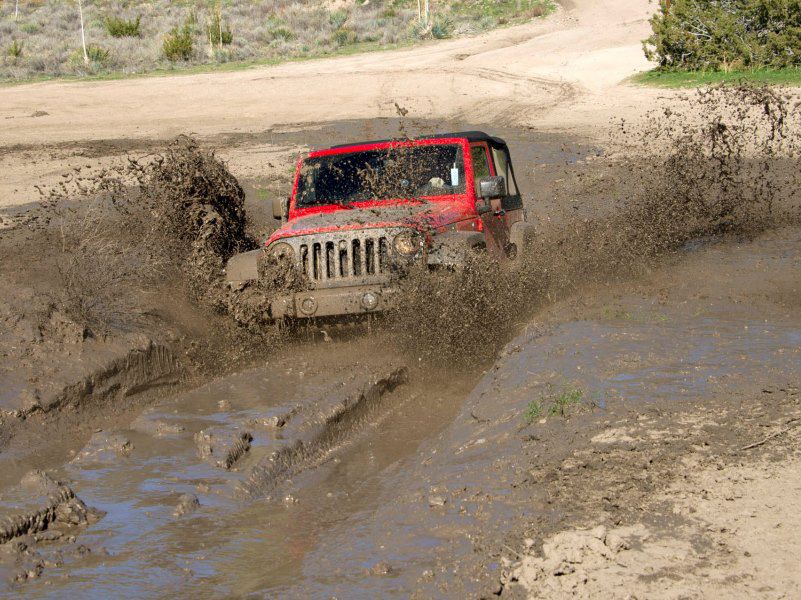
Mud Fun
An hour into our adventure, the bright Firecracker Red Jeep has lost its glossy luster and is now coated in a layer of gritty California mud. Thick streams of the wet goop are thrown everywhere by the blocky tires, and in a mad-fun sort of way my enjoyment increases as my son whoops in delight. (Rain-sensing automatic windshield wipers, which this model does not have, would have helped keep the front glass clean during our frequent splashdowns.)
After diving through deep puddles and inching my way over dirt berms that would trap or high-center lesser 4×4 vehicles, I head for the mountains surrounding the river bed. I point the Jeep’s square nose towards the sky, and it claws itself up steep hills as if attached to a cable. I tepidly step down even steeper hills. Three hours later, I come to a realization: The only obstacle hindering the Willys Wheeler’s progress over the intimidating multi-diamond trails is fear – mine.
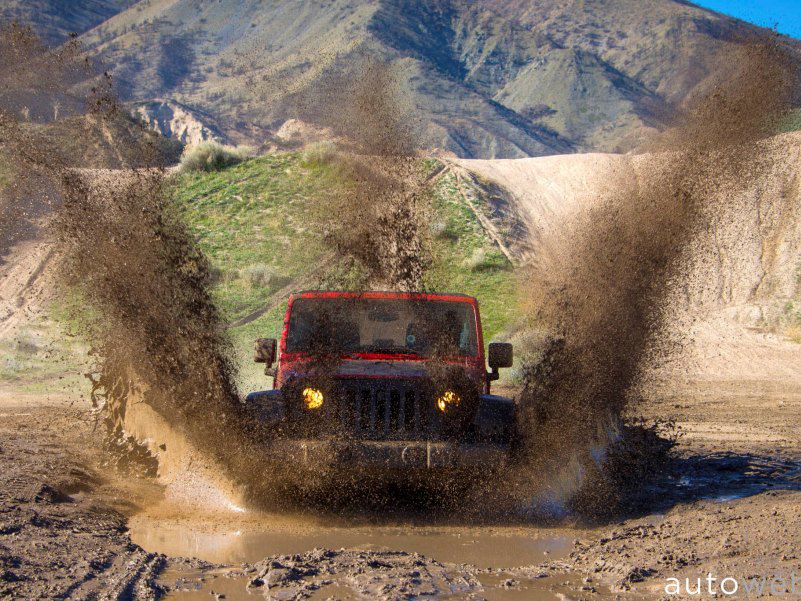
Emotional Appeal
In its proper venue – where the path ahead is unpaved and difficult – the Wrangler is as emotionally gratifying as a 458 Spider is on a racetrack. Both Jeep and Ferrari are purpose-built machines that can plaster exceptionally wide smiles on the faces of their owners, and neither disappoints when driven with skill and finesse. Their capabilities are meant to be explored, and they deliver superbly well in the most extreme situations.
Yet, unlike like the Ferrari, the Jeep lacks engineering supremacy, sexiness, and prestige. And, truth be told, its stage presence is limited. But that doesn’t mean those who own this capable off-roader are bland. Jeep owners come from every walk of life (it is difficult for a bystander to pin down the average household income of a Wrangler owner driving by), and sitting behind the wheel projects a youthful, daring and adventurous lifestyle. It is an infectious feeling and makes Wrangler owners particularly loyal to the brand.

The Final Verdict
If the 2015 Jeep Wrangler were a Swiss Army knife, it would have just one blade between its two red plastic halves – the stainless steel serrated saw designed to cut down small trees. In a similar manner to that one-mission blade, the Jeep is the proper tool for hurling over boulders, fording streams, and squishing through mud. For most every other mission, it is the wrong apparatus.
But instead of focusing on its countless compromises and woeful inadequacies, the Wrangler deserves to be accepted as a traditional off-road truck that has diligently survived 63 years of a rapidly changing automotive environment. Today, it hurriedly moves off the showroom floor without apology or excuse, and delivers excellent resale value, just by the simple all-encompassing explanation, “It’s a Jeep.”
